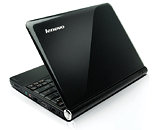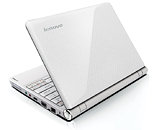Monday, May 25th 2009

Lenovo Debuts First Netbook with NVIDIA ION Graphics Processor
Lenovo today announced the IdeaPad S12, the company's first 12-inch netbook. The new netbook takes the best in connectivity, style and entertainment features in Lenovo's other netbooks and brings users the next level in netbook computing with improved usability and performance. These enhancements include a 12.1-inch screen, a 100 percent full-size keyboard and new graphics options with the NVIDIA ION platform.
"We've heard from consumers loud and clear about the need for affordable and extremely portable computing devices, and we've responded by introducing our third netbook with a completely new form factor, making mini-computing more usable and redefining value in today's market," said Dion Weisler, vice president, Business Operations, Idea Product Group, Lenovo. "We are pioneering new territory in the developing netbook arena by being the first vendor to give customers high quality video and entertainment capabilities in a netbook with optional NVIDIA ION graphics."Elevating Power and Performance
Whether it's looking at photos, playing music, emailing or cruising online, consumers want smaller and more portable PCs. The Lenovo IdeaPad S12 netbook is raising the bar for higher levels of netbook computing with choices of the Intel Atom processor with Intel integrated graphics or the Intel Atom processor with NVIDIA ION graphics. Also, for the first time on a netbook with NVIDIA's ION graphics platform, users will be able to enjoy brilliant 1080p high definition video with silky smooth playback.
"NVIDIA ION graphics help deliver the same features found in premium PCs at lower price points and new form factors," said Rene Haas, general manager, Notebook GPUs, NVIDIA. "With enhanced graphics, the Lenovo IdeaPad S12 netbook is perfect for watching movies, playing popular games like Spore, flipping through vacation pictures or enhancing family videos."
The IdeaPad S12 netbook offers plenty of up and running time with up to six hours of battery life to support the mobile demands of netbook users1. Because netbook users need to stay connected wirelessly, the netbook comes with WiFi connectivity and ready for 3G with an ExpressCard slot to enable connectivity2. To hold the photos, music and videos users keep on their netbooks, the IdeaPad S12 netbook offers ample hard drive storage and memory with up to 160 GB of storage and 1 GB of memory. For peace of mind in case data becomes corrupted, Lenovo's OneKey Rescue System can help recover user data or device settings.
Loaded with Style and Entertainment
In addition to the netbook's sleek and sophisticated ring pattern design in black or white, users can make the netbook their one-stop entertainment device, starting from the moment they turn it on. Lenovo's expanded VeriFace facial recognition technology makes logging in a snap by recognizing the user's face. If users want "on demand" functionality, they can go into the Lenovo Quick Start environment and check email, browse the Internet and more without waiting for the full operating system to boot. They can also don any set of headphones and enjoy surround sound audio with Dolby Headphone technology. If opting to watch video on an external monitor, they can easily connect through the netbook's VGA port or HDMI port on select models. They can also choose among several multimedia formats to upload through the 4-in-1 multicard reader.
An Improved Computing Experience
Lenovo designed the IdeaPad S12 netbook for consumers looking for a super thin, portable and affordable device that offered a familiar, computing experience. Lenovo enlarged the netbook's WXGA screen from 10.1 inches to 12.1 inches for better viewing and made the keyboard 100 percent the size of a full-size laptop to make typing easier and less cramped. And when it comes to portability, by measuring less than an inch thick4, the netbook leads the industry for thinness compared to other 12-inch netbooks. The lightweight IdeaPad S12 netbook weighs in at just three pounds.
Product Details
Source:
HotHardware
"We've heard from consumers loud and clear about the need for affordable and extremely portable computing devices, and we've responded by introducing our third netbook with a completely new form factor, making mini-computing more usable and redefining value in today's market," said Dion Weisler, vice president, Business Operations, Idea Product Group, Lenovo. "We are pioneering new territory in the developing netbook arena by being the first vendor to give customers high quality video and entertainment capabilities in a netbook with optional NVIDIA ION graphics."Elevating Power and Performance
Whether it's looking at photos, playing music, emailing or cruising online, consumers want smaller and more portable PCs. The Lenovo IdeaPad S12 netbook is raising the bar for higher levels of netbook computing with choices of the Intel Atom processor with Intel integrated graphics or the Intel Atom processor with NVIDIA ION graphics. Also, for the first time on a netbook with NVIDIA's ION graphics platform, users will be able to enjoy brilliant 1080p high definition video with silky smooth playback.
"NVIDIA ION graphics help deliver the same features found in premium PCs at lower price points and new form factors," said Rene Haas, general manager, Notebook GPUs, NVIDIA. "With enhanced graphics, the Lenovo IdeaPad S12 netbook is perfect for watching movies, playing popular games like Spore, flipping through vacation pictures or enhancing family videos."
The IdeaPad S12 netbook offers plenty of up and running time with up to six hours of battery life to support the mobile demands of netbook users1. Because netbook users need to stay connected wirelessly, the netbook comes with WiFi connectivity and ready for 3G with an ExpressCard slot to enable connectivity2. To hold the photos, music and videos users keep on their netbooks, the IdeaPad S12 netbook offers ample hard drive storage and memory with up to 160 GB of storage and 1 GB of memory. For peace of mind in case data becomes corrupted, Lenovo's OneKey Rescue System can help recover user data or device settings.
Loaded with Style and Entertainment
In addition to the netbook's sleek and sophisticated ring pattern design in black or white, users can make the netbook their one-stop entertainment device, starting from the moment they turn it on. Lenovo's expanded VeriFace facial recognition technology makes logging in a snap by recognizing the user's face. If users want "on demand" functionality, they can go into the Lenovo Quick Start environment and check email, browse the Internet and more without waiting for the full operating system to boot. They can also don any set of headphones and enjoy surround sound audio with Dolby Headphone technology. If opting to watch video on an external monitor, they can easily connect through the netbook's VGA port or HDMI port on select models. They can also choose among several multimedia formats to upload through the 4-in-1 multicard reader.
An Improved Computing Experience
Lenovo designed the IdeaPad S12 netbook for consumers looking for a super thin, portable and affordable device that offered a familiar, computing experience. Lenovo enlarged the netbook's WXGA screen from 10.1 inches to 12.1 inches for better viewing and made the keyboard 100 percent the size of a full-size laptop to make typing easier and less cramped. And when it comes to portability, by measuring less than an inch thick4, the netbook leads the industry for thinness compared to other 12-inch netbooks. The lightweight IdeaPad S12 netbook weighs in at just three pounds.
Product Details
- 12.1 WXGA (1280 X 800) LED 200 nit, 250g display
- Intel Atom N270 processor
- Intel integrated GMA 950/ Nvidia ION
- Up to 1GB DDR2 533 MHz memory
- Up to 160 GB SATA storage
- 3 hours with 3-cell, 6 hours with 6-cell
- 1.4kg with 3 cell, 1.55kg with 6 cell
- Dimensions: 292 X 216 X 22-28.9mm
- Connectivity: 10/100m Ethernet, Broadcom 578M, Intel WiFi Link 5150 1X2 AGN, Intel WiFi Link 5100 1X2 AGN, Non-Intel wireless b/g, Non-Intel wireless b/g/n, Bluetooth
- Expansion: 3 USB, 1 Expresscard slot (Intel and VIA platforms), 4-in-1 card reader, VGA, RJA45, HDMI
- XP Home SP3 (32 bit) OS



31 Comments on Lenovo Debuts First Netbook with NVIDIA ION Graphics Processor
I know this is rivaling notebook specs but I am thinking long lasting battery an a very small footprint would make this an awesome netbook.
For longer battery, I believe the Z530/Z540 would be a better chip, right? Why are they using the 270 when the 280 is faster and the Z540 is faster still and also lower power?
Also, Microsoft limits XP to machines with 1 GB of RAM installed by the OEM; you can still upgrade it to 2 GB of even 4 GB after purchase.
It will ship with 1GB of memory, but the chipset support up to 4GB, so just upgrade it yourself.
The limitation is imposed by Microsoft, not by the hardware... :banghead:
Besides, the main selling point of a dual-core Atom Netbook would be the ability to play 1080p video. With that, the netbook line would be complete.
en.wikipedia.org/wiki/AMD_mobile_platform#Yukon_platform_.282009.29
processorfinder.intel.com/List.aspx?ParentRadio=All&ProcFam=3008&SearchKey=
Note also that many many codecs are still not multithread optimised. To get GREAT HD performance, leave it to the chipset to accelerate; one of the main features of ION.
Your argument against having more than one thread was refuted years ago by me and the others when Quad cores came into the picture. I have an N270 laptop. I just built an Atom 330 Mini-ITX computer (as can be seen in my temporary sig). The performance difference in just windows (considering Windows itself knows how to take control of more than one thread for each window/internal application), is just what I expected. Opening Word documents has become twice as fast, surfing the net, multi-tasking.. everything pretty much. Now, if I were to emulate Nintendo DS via No$GBA, yes, maybe it wouldn't matter to have two cores. As for power consumption - the chipset alone takes as much as an extra two N270's.
I can tell in your voice that you own a single-core Atom. And I am sorry, but this is the truth. I own both - I have no reason to pick a side. But I picked my Quad core over the E6850 when everyone loved the E6750, and I'm going to build an 8-core system next, because it just pays off.
Also, unless you want to find an external Blu-ray/HD-DVD player to hook up to the Netbook, ION will be useless. Running H.264 files only utilizes the CPU. Which is why Atom 330 is a god-send.